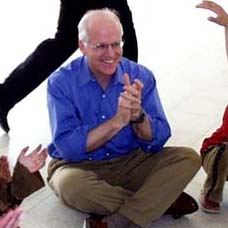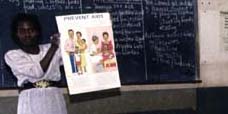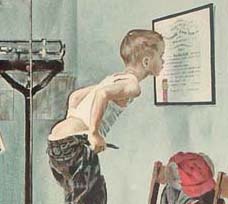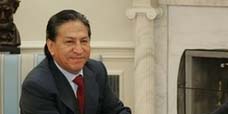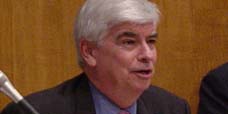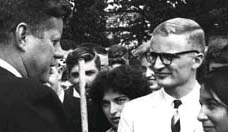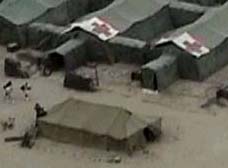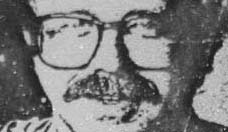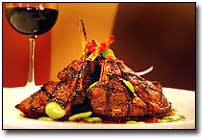
The success of Doris Rodriguez de Platt and her family reflects the burgeoning interest in the foodways of the third largest South American country. Peruvian cuisine, with its mix of immigrant influences and characteristic native ingredients including colorful corn, chiles and potatoes, is exploding onto the culinary scene here and abroad, particularly in Japan, Spain and other parts of Europe and Canada.
When "Mama Doris," wife of Peru RPCV John Platt, opened a sophisticated New Andean Peruvian restaurant in this city's fashionable Pearl District three years ago, she never imagined the enthusiastic response
DISTINCTIVE: Peruvian food is exploding onto the culinary scene
By Joan Cirillo
THE ASSOCIATED PRESS
PORTLAND, Ore. - When "Mama Doris" opened a sophisticated New Andean Peruvian restaurant in this city's fashionable Pearl District three years ago, she never imagined the enthusiastic response.
Her family restaurant, Andina, quickly generated a buzz on the national and local scenes. The year after it opened, Gourmet magazine wrote: "A rare Peruvian gem filled with folk art and weavings, this is unique on the West Coast." Last year, The Oregonian, the state's largest newspaper, named it restaurant of the year.
What had mouths watering were the distinctive flavors of dishes like the clean-tasting white fish ceviche (raw fish "cooked" in Key-lime juice), made from sea bass or ono; the fish and meat anticuchos (brochettes marinated and seasoned with Peruvian peppers such as aji panca, a dry red hot pepper, or rocoto, red hot pepper); and the brilliantly colored causa (mashed potatoes with lime and chili pepper), made from Peruvian purple potatoes and filled with pink salmon or shrimp.
The success of Doris Rodriguez de Platt and her family reflects the burgeoning interest in the foodways of the third largest South American country.
Peruvian cuisine, with its mix of immigrant influences and characteristic native ingredients including colorful corn, chiles and potatoes, is exploding onto the culinary scene here and abroad, particularly in Japan, Spain and other parts of Europe and Canada.
New restaurants are opening. Fresh produce, such as Peruvian peppers, is showing up in markets, and such exports as chocolate and organic coffee are finding a following in the United States for their taste, competitive pricing and variety.
Latin importer Goya Foods doubled its Peruvian product line this spring and plans more growth. An expanded line of Peru's distinctive chili pastes and peppers is among the newest items in Goya's 34-product Peruvian line (www.goya.com).
Search the Internet and you'll find these and other products for sale along with blogs (www.perufood.blogspot.com) and Web sites created by Peruvian food enthusiasts (www.artperucuisine.com and (www.abundantetv.com).
"Americans are always hungry for something different and new," said Joseph Perez of Goya headquarters in Secaucus, N.J. A vice president specializing in Latin markets, Perez attributes the escalating interest to "the realization that Peruvian cuisine is one of the most highly versatile and sophisticated cuisines in the world."
Peruvian cuisine is characterized by its use of hot peppers and aromatic herbs and the interweaving of other ethnic traditions and techniques with indigenous foods. Less spicy than Mexican, the cuisine uses the range of native chiles from red to purple to add color to a dish and a piquant, underlying flavor that accents rather than heats. For instance, at the restaurant Andina, the red thin-skinned piquillo pepper comes stripped of the veins bearing heat and is stuffed with a mixture of cheese, quinoa and serrano ham.
Like the Mediterranean with its fresh flavors, the cuisine varies regionally but is always influenced by aromatic herbs, including some native herbs such as huacatay (black mint), cilantro, oregano and basil, to showcase the ingredients particular to the region.
Top food professionals got a taste of it at the International Association of Culinary Professionals' annual conference in Seattle this year. As they dined on ceviche, papa (potato) a la Huancaina and giant Peruvian corn, television host David Jesson showed products and slides of the countryside and its bounty.
An American who has been a chef since 1980, Jesson was ordained a pastor 10 years ago and moved to Peru in 2001 to work in hunger relief. For the past three years, Jesson has been covering Peruvian culture and cuisine as the producer and host of the nonprofit Christian show, Abundante (www.abundantetv.com).
Peruvian cuisine owes much to the combination of its rich natural resources with the traditions of immigrant ethnic groups. Peru enjoys the bounty of three clearly different regions: the coast and its desert; the Andean Mountains; and the Amazon jungle.
The indigenous foods of the Incas, including quinoa, corn, fish and potatoes, were embellished by the Spanish and their inheritance of Moorish cooking styles. When Chinese immigrants went to Peru to work the railroads in the mid-19th century, they left their mark by introducing stir-fry, soy sauce and ginger.
The Italians brought their Mediterranean flavors and noodles, and the Japanese and African added the customs and flavors of their countries to what they found. Their techniques and ingredients resulted in distinct cooking styles layered over existing Peruvian foods.
Over the last 20 years, Peruvian cuisine has continued to evolve with the Novo Andina or New Andean movement, generated by chefs from Lima, the nation's capital. Chefs are rediscovering and reinventing traditional foods by applying sophisticated culinary techniques from other countries and taking those ideas to other countries.
These recipes are from Rodriguez de Platt of the New Andean-style restaurant Andina in Portland, Ore.:
Papa a la Huancaina
Papa a la Huancaina (sliced boiled potatoes with a delicate spicy cream sauce) is a signature dish of Huancayo, a central Andean city famous for its cheese and aji amarillo (yellow chile peppers), and it's a popular use of Peru's many potato varieties.
This recipe makes 2 3/4 cups of sauce. Use extra sauce as a dip for crudites, fried yuca or corn on the cob. Wear plastic gloves while handling habaneros to protect skin.
6 Yukon Gold potatoes or a combination of Yukon Gold and purple potatoes, washed
2 tablespoons canola oil
1/2 large yellow bell pepper, sliced
1 small habanero pepper, halved, seeds and veins removed and well rinsed or 1 tablespoon aji amarillo paste, available in specialty Latin markets
8 ounces (1 cup) ricotta cheese
4 hard-cooked eggs
6 ounces cream cheese
1/4 cup milk, if needed
1 1/2 teaspoons salt
12 botija (purple Peruvian) olives (See Note)
8 butter lettuce leaves, washed and patted dry
Black sesame seeds, optional garnish
1. In a medium pot, cover potatoes with salted water and cook until tender but firm.
2. While potatoes are cooking, make the sauce. In a blender, add oil, bell pepper and habanero pepper or aji paste and liquefy. Blend in ricotta cheese, a little at a time, followed by 2 hard-cooked eggs, cut in half. Add cream cheese in chunks. If sauce is too thick, add milk to bring it to the consistency of yogurt. Add salt.
3. When potatoes are cooked, allow them to cool, then peel and slice each potato crosswise to make 3 to 4 slices per potato. Place lettuce leaves on individual plates. Fan potatoes out beside or over lettuce and cover with cream sauce. Cut remaining 2 hard-cooked eggs in half. Garnish each plate with egg and olives. Garnish with black sesame seeds if desired. Serve at room temperature.
Makes four servings.
Note: Purple Peruvian botija olives are available at ethnic and specialty-food markets.
Lomo Saltado
The Chinese influence on Peruvian cuisine is exemplified in this popular stir-fry of beef with onions and tomatoes. Thin slices of marinated beef are quickly stir-fried with onions and tomatoes and seasoned with vinegar and soy sauce. The dish may be accompanied by fried yuca and garlic rice.
2 tablespoons olive oil
3 to 4 garlic cloves, minced
1/4 teaspoon ground cumin
2 teaspoons red-wine vinegar or Key-lime juice
2 teaspoons soy sauce
1 1/4 pounds beef tenderloin, cut into thin strips (1/2-by-1/2-by-2-inch)
Salt and pepper to taste
1 medium red onion, sliced
3 tomatoes, seeds removed and sliced into wedges
1 tablespoon chopped cilantro
1. In a small bowl, combine 1 tablespoon olive oil, garlic, cumin, 1 teaspoon vinegar or lime juice and 1 teaspoon soy sauce. Add meat, sprinkle with salt and pepper to taste, and toss meat to cover with liquid. Set aside to marinate at room temperature for 30 minutes.
2. When meat is ready, heat remaining tablespoon of oil in a wok or frying pan until smoking. Oil must be very hot. Add beef strips and stir-fry until meat is browned on all sides, about one to two minutes. Turn meat constantly and cook in batches, if necessary, to avoid steaming meat.
3. Add onion and stir-fry until slightly transparent but still firm, about one to two minutes. Toss in tomatoes and sprinkle with 1 teaspoon of vinegar and 1 teaspoon of soy sauce. Stir-fry just to combine ingredients, taking care not to overcook tomatoes. Tomatoes should be slightly firm and just heated.
4. Sprinkle cilantro over mixture and toss lightly to distribute evenly. Remove immediately from heat to prevent overcooking.
Makes four servings.
Fried Yuca (Cassava)
Yuca, also known as cassava, is available in Latin-American and Caribbean markets. In the following recipe, this starchy vegetable is boiled and then lightly fried to bring out the flavor.
1 large yuca
Salt
Olive oil for frying
1. Peel the waxy bark and any pink away from yucca to expose the white pulp. Use the tip of a sharp knife to pick out any black spots or "eyes" of the yuca. Cut yuca crosswise into fourths and place in a medium saucepan filled with enough salted water to cover yuca.
2. Bring water to a boil, then simmer covered for about 45 minutes or until yuca can be pierced easily with a knife. Yuca will become starchy, glossy and translucent but should be firm enough to hold its shape. The center may remain white but should be tender.
3. Remove yuca from pan and cut into 2-by-4-inch pieces. Pat lightly with paper towels to dry. Cover the surface of a frying pan with oil. Heat until smoking, and add yuca. Fry and turn until golden brown on all sides, about 10 minutes. Serve hot.
Makes four servings.
Peruvian-style Garlic Rice
1/4 cup extra-virgin olive oil, plus extra for greasing serving cups
2 to 3 cloves garlic, minced
3 cups water
3/4 teaspoon salt
1 1/2 cups long-grain rice
Heat oil in a saucepan, add garlic and cook, stirring, until garlic is pale golden. Add water and salt, and bring to a boil on medium high heat. Add rice, stir, and return to a boil. Reduce heat to medium low and simmer, covered, for 20 to 25 minutes or until water is absorbed and rice is tender. To serve, lightly oil a 1-cup dry measure or small custard cup, and pack warm rice firmly into cup. Invert onto serving plate, tapping lightly to release rice.
Makes four servings.
